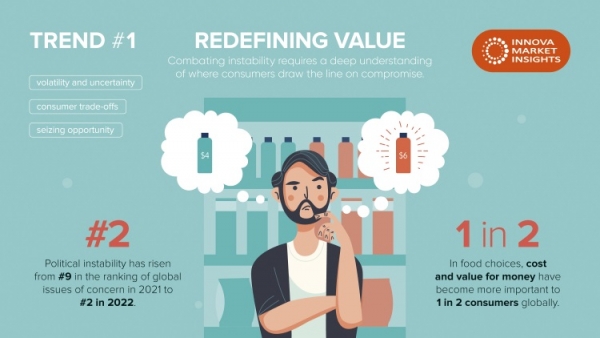It's no surprise that cost-cutting and value for money are slated as the top trends for 2023

Brands, producers and retailers are wrestling with rising costs and greater instability, but so too are consumers, with many tightening belts more than ever before and seeking out value in areas previously not possibly considered. To maintain a loyal customer base will require a deep understanding of where consumers draw the line on compromise, said Innova.
This is just one of the insights gleaned from wide-ranging global consumer surveys by the market intelligence firm.
Coupled with comprehensive market and new product data, it has teased a snapshot of its well-regarded annual trends report, which reveals not only what is driving consumer decisions now, but also ways in which brands can successfully adapt to future realities.
Over the past year, the price of goods and value-for-money have become the leading priority for the majority of food shoppers worldwide.
In this inflationary environment, they are increasingly searching out money-saving offers, such as choosing cost items and cooking from scratch. However, said Innova, they are not as yet prepared to compromise completely, and many remain determined to sample new experiences, increase their personal wellbeing through better-for-you foods and support planetary health.
As such, there is far more pressure on manufacturers to deliver value while still meeting these wider public expectations.
“Redefining value throughout the food and beverage industry will lead in 2023 as consumers seek brands that listen, understand and respond to their core values,” said Lu Ann Williams, Global Insights director for Innova.
“They want brands that provide quality, trust and confidence via their product formulations, communications and wider sustainability actions.”
Meanwhile, younger generations who have grown up in an inclusive digital age are gaining greater influence, changing markets and creating new opportunities.
Against this complex backdrop, here’s a taste of what Innova believes will be the top five standout trends for 2023.
Redefining value
Brand owners will need to be more flexible than ever before, and adopt short-term strategies like simple price increases or flexible ingredient lists to cope with supply chain fluctuations. However, it is essential for them to be open in their communication and clearly show the benefits they are still offering.
Despite the political and economic upheaval that is fast becoming the second biggest concern for consumers in 2022, the health of the planet remains the top global issue. In fact, in tightening their purses, consumers are seeing the cost-savings in eco-friendly behaviours.
Innova’s data reveals consumers are on a big push to reduce food waste and upcycled or recycled more as part of their belt-tightening. As the cost-of-living crisis continues, brands can achieve success through actions that combine economic benefits with clear health and sustainability goals.
Affordable nutrition
Over the past 12 months, 62% of consumers have reported a noticeable rise in the cost of food; many turning their attention to simple but nutritious goods that are affordable. Key behaviours include buying in bulk, opting for private labels, cooking from scratch, reducing spending on luxury items and purchasing fewer items.
On the other hand, consumers are actively looking to maintain a healthy diet, offering brands many opportunities to test their capabilities to new limits and come up with affordable option.
To meet the nutritional, environmental and economic demands of consumers, manufacturers must innovate to extract maximum value from raw materials and the production process.
Generational push
For Gen Z and Millennials, food and brand choices are important signifiers of lifestyle, beliefs and values. These demographics have a strong voice and are used to sharing their views openly and widely. They’ve also been raised in an interactive digital world, which means they have the power to create trends and define what markets should be providing.
While health is an important purchase driver – as it is across older generations – the younger set embrace the new and different, while being extremely responsive to positive engagement from brands.
Unlocking a new narrative around plant-based
According to Innova, the precipitous rise of the plant-based movement has inevitably hit some roadblocks, necessitating a refocusing on consumer demands for high quality, flavoursome products.
It’s no longer merely a green mimic of gastronomy, but will blossom as a standalone sector in 2023, meaning consumers will demand improvements in taste and texture. There is also a huge appetite for global flavour profiles – two-thirds of respondents to Innova’s survey expressed a desire to try plant-based versions of traditional cuisines – giving brands significant opportunities to diversify and expand.
Interest in underused ingredients is also growing, creating opportunities to introduce variation in flavour and nutrition, while simultaneously addressing supply concerns.
Farming the future
There’s growing consumer curiosity for innovative tech such as vertical and regenerative farming. As well as helping to maximise flavour, nutrition and yield, these advances are resonating with consumers for their sustainability approach. Today’s shopper is increasingly invested in the source of food as it ties in with the major global concerns of health, sustainability and waste.
The welfare of workers is equally important, with 65% of respondents stating they would rather buy direct from farmer’s markets than large stores. As such, it’s becoming increasingly important for brands to demonstrate if and how their production are benefiting farmers, people and the planet.
Significant year for new developments
The five remaining trends in Innova’s 2023 roundup include insights into quality, digital opportunities, revenge spending, unpuzzling health and embracing the positively imperfect. Brand owners can find out more in a webinar being hosted by Williams on 9 November.
”We have seen a considerable consumer demand for value redefined throughout the supply chain, with creative and flexible approaches to the use of technology and reducing waste proving pivotal,” said Williams.
“With financial concerns a dominating factor, 2023 is a significant year for new developments that answer these growing demands. Based on our consumer and market research, our Top Trends deliver insights to support brands as they innovate and grow.”













